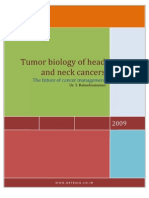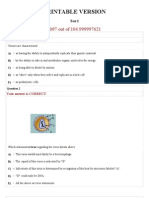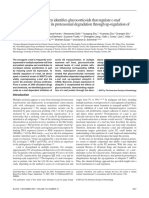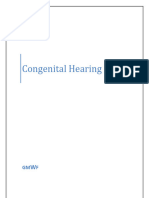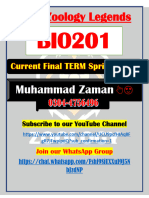Lecture COPEG Qns (Last Lect)
Lecture COPEG Qns (Last Lect)
Uploaded by
Wesley TanCopyright:
Available Formats
Lecture COPEG Qns (Last Lect)
Lecture COPEG Qns (Last Lect)
Uploaded by
Wesley TanOriginal Description:
Copyright
Available Formats
Share this document
Did you find this document useful?
Is this content inappropriate?
Copyright:
Available Formats
Lecture COPEG Qns (Last Lect)
Lecture COPEG Qns (Last Lect)
Uploaded by
Wesley TanCopyright:
Available Formats
H2 Biology COPEG Extra Lesson
ACJC
1 With reference to prokaryotic and eukaryotic genomes, which of the following
statement is not true?
A
B
C
D
They both have extrachromosomal DNA.
They both have non-coding regions.
They both have regulatory sequences.
They are both associated with histones.
2 Within a cell, the amount of polypeptide made using a given mRNA molecule
depends partly on
A
B
C
D
the degree of DNA methylation
the rate of which the mRNA is degraded
the presence of transcription factors
the types of ribosomes present in the cytoplasm
3 The diagram below shows how acetylation of histones promotes loose chromatin
structure. Recent evidence has shown that chemical modification of histones play
a direct role in regulation of gene expression.
Which of the following best explains how acetylation regulates gene expression?
histone deacetylase
histone acetylase
histone tail
H2 Biology COPEG Extra Lesson
ACJC
A Helicase action is enhanced by acetylation.
B Acetylation of histones neutralizes their negative charges and encourages
binding to DNA polymerase.
C When nucleosomes are highly acetylated, chromatin becomes less compact
and DNA is more accessible for transcription.
D RNA polymerase works better by binding with acetyl groups.
4 Which of the following is an example of a possible step in the post-transcriptional
control of gene expression?
A The addition of methyl groups to cytosine bases of DNA.
B The binding of transcription factors to a promoter.
C The removal of introns and splicing together of exons.
D Gene amplification during a stage in development.
5 The globin gene family in humans consists of the , and genes. These genes
code for the globin chains that make up haemoglobin and are expressed at
different levels during different developmental stages. The graph shows the
expression of the various globin chains during the prenatal (fetal) and postnatal
(after birth) periods.
H2 Biology COPEG Extra Lesson
ACJC
H2 Biology COPEG Extra Lesson
ACJC
H2 Biology COPEG Extra Lesson
ACJC
Which of the following cannot account for the differences in the levels of
expression of globin chains?
A Methyl groups are added to regulatory sequences of -globin genes during
the postnatal period, allowing for some proteins to bind.
B Alternative splicing has occurred to form the mature mRNA of the -globin and
Birth
-globin genes, resulting in differences
in the rate of expression of globin
chains during the prenatal period.
C A growth factor triggers the expression of a transcription factor that increases
the rate of -globin gene expression during the postnatal period.
D The shortening of poly(A) tail in the mRNA of globin genes reduces its
stability, resulting in a decrease in the rate of expression of -globin chains
during the postnatal period.
6 Which of the following experimental procedures is most likely to hasten mRNA
100in a eukaryotic cell?
degradation
A
B
C
D
enzymatic shortening of the poly(A) tail
methylation
ofChains
C nucleotides
% of Globin
removal of the 5' cap
removal of one or more exons
50
Prenatal
Postnatal
7 A geneticist introduces a transgene into yeast cells and isolates five independent
cell lines in which the transgene has integrated into the yeast genome. In four of
the lines, the transgene is expressed strongly, but in the fifth there is no
expression 0 at all. Which is a likely explanation for the lack of transgene
expression in0the 2fifth 4cell 6line?8 0 2 4 6 8 10 12
A A transgene integrated into a heterochromatic region of the genome.
Age (months)
B A transgene integrated into a euchromatic
region of the genome
C The transgene was mutated during the process of integration into the host cell
genome
D A transgene integrated into a region of the genome characterized by high
histone acetylation
8 Which of the following about eukaryotic control elements are correct?
1 attachment of RNA polymerase to promoter requires interaction with activator
proteins
2 attachment of activator proteins to enhancers increases the basal activity of
the promoter
3 attachment of activator proteins to silencers suppresses the basal activity of
the promoter
4 enhancers and silencers are DNA sequences usually found upstream of
structural genes and can regulate gene expression
A 2 and 4
H2 Biology COPEG Extra Lesson
ACJC
B 3 and 4
C 1, 2 and 4
D 1, 3 and 4
9 The percentage of the human genome that is transcribed is larger than that
predicted based on the range of proteins made by the cell. Which of the following
accounts for the difference?
A Alternative splicing can result in more than one kind of protein produced from
one gene.
B Some genes are transcribed to produce RNA that is not meant to serve as a
template for protein synthesis.
C The enhancers present in the human genome are also transcribed to bring
about an increase in the transcription of protein-coding genes.
D The telomeric regions are also transcribed to give telomerase, which helps to
maintain the telomere length.
10 The following events occur in the extension of telomeres.
1
2
3
4
Further extension of 3 end of telomere
Translocation of telomerase to end of telomere
Reverse transcription to extend the 3 end of the telomere
Complementary base-pairing of RNA template with single-stranded end
of telomere
DNA polymerase catalyses formation of complementary strand to form
double stranded DNA.
In which order do these events take place?
A
B
C
D
3
3
4
4
2
4
2
3
4
2
3
2
5
1
5
1
1
5
1
5
11 Which of the following methods of regulating gene expression is common to both
prokaryotes and eukaryotes?
A Binding of proteins to control elements
B DNA methylation
C Histone acetylation
D Post-transcriptional modification of RNA
H2 Biology COPEG Extra Lesson
ACJC
12 Which of the following about cancerous cells is false?
A
B
C
D
They are able to divide for a certain number of times and then stop dividing.
They are able to divide further when in contact with neighbouring cells.
They are not able to differentiate properly.
They are not able to exhibit anchorage dependence.
13 Which of the following statements about cancer is / are true?
A
B
C
D
Cancer is a result of increased cell division which promotes the mutation of a protooncogene.
Individuals who inherit one inactive copy of tumour suppressor gene are more likely
to develop cancer than individuals with two non-mutant copies.
Mutagenic activation of a single oncogene is sufficient to convert a normal cell into
a cancer cell.
2 only
1 and 3
2 and 3
All of the above
Fig. 1 below shows the various parts of a gene.
Regulatory sequence 1Regulatory sequence 2
Promoter
E1
Poly(A) addition
Termination
signal
sequence
I1
E2
I2
E3
I3
E4
E = exon, I = intron
Fig. 1
a) Describe the role of regulatory sequence 1 in causing the gene to be expressed. [4]
1) Specific transcription factors activators bind to the enhancers ;
2) This recruits a DNA-bending protein which causes the DNA to bend to bring the
activator close to the promoter;
3) Mediator proteins will bind to the bound activators, recruiting RNA polymerase and
general transcription factors to the promoter;
4) forming the transcription initiation complex on the promoter;
5) transcription of gene at a high rate; @ 1 mark
b) Explain what could happen to gene expression if a short sequence of DNA was inserted
into or near the
(i)
Promoter [2]
1. RNA polymerase may not be able to bind to the disrupted promoter
2. due to sequence not complementary to binding site of RNA polymerase / TATA box
binding protein);
H2 Biology COPEG Extra Lesson
ACJC
3. and so gene becomes transcriptionally inactive / silenced ;
(ii)
Poly(A) addition signal [2]
With the poly(A) addition signal disrupted, the mRNA formed does not have a poly(A) tail;
This decreases the stability of the mRNA/decreases its half-life/causes mRNA to be
degraded ;
Hence gene is less expressed ; @ 1 mark
(c) Describe the role of tumour suppressor genes in normal cells. [2]
Tumour suppressor genes code for proteins which
1. are involved in DNA repair/fixing damaged or broken DNA
2. cause (mutated) cells to undergo apoptosis.
3. control the adhesion of cells to each other or to an extracellular matrix.
4. are components of cell-signalling pathways that inhibit the cell cycle.
@ mk
(d) Predict whether a mutation in the tumour suppressor gene will be a dominant or recessive
mutation. Give reasons for your answer. [2]
1. Recessive mutation.
2. Loss of function mutation, which means that the normal, non-mutated gene can still function
and used for synthesis of tumour suppressor protein;
3. Both genes must be mutated for tumour suppressor protein to be non-functional;
@ 1mk
(e) Describe one other way in which a cells ability to proliferate can become uncontrolled.[4]
You might also like
- NUS Scholarships Referee Information SheetDocument2 pagesNUS Scholarships Referee Information SheetWesley TanNo ratings yet
- 2016 Sem 1 Finals W AnsDocument9 pages2016 Sem 1 Finals W AnsWesley Tan100% (1)
- SMIB032 Test 2 Memorandum - PDF 2Document7 pagesSMIB032 Test 2 Memorandum - PDF 2lion2ndtNo ratings yet
- Chapter 03Document4 pagesChapter 03Teehee JonesNo ratings yet
- SSN SBPM Workshop Exam One Multiple Choice QuestionsDocument10 pagesSSN SBPM Workshop Exam One Multiple Choice QuestionsAG KhanNo ratings yet
- Bioinformatics Assignment: Medha Banerjee 1660091 IMTH-7 (A)Document11 pagesBioinformatics Assignment: Medha Banerjee 1660091 IMTH-7 (A)Medha BanerjeeNo ratings yet
- 2015 Revision Tutorial Core Topic 2 and 4 AnsDocument35 pages2015 Revision Tutorial Core Topic 2 and 4 AnsliveaqNo ratings yet
- Practice Prelim 3Document5 pagesPractice Prelim 3Lauren PriscoNo ratings yet
- SPOP mutation induces replication over-firing by impairing Geminin ubiquitination and triggers replication catastrophe upon ATR inhibitionDocument15 pagesSPOP mutation induces replication over-firing by impairing Geminin ubiquitination and triggers replication catastrophe upon ATR inhibitionrhwhitakerNo ratings yet
- Exame 1 2012-2013 ENDocument7 pagesExame 1 2012-2013 ENJoão BarreiraNo ratings yet
- The Birth and Death of GenesDocument6 pagesThe Birth and Death of Genestelangsanika07No ratings yet
- AP Biology Review Chapters 12 Review Questions Chapter 12: Molecular Biology of The GeneDocument2 pagesAP Biology Review Chapters 12 Review Questions Chapter 12: Molecular Biology of The GeneNaviIxNo ratings yet
- Bio1A03 Practice Test 2Document11 pagesBio1A03 Practice Test 2cbox4273No ratings yet
- Midterm #1Document8 pagesMidterm #1Clarence YeungNo ratings yet
- Tutorial 1 & 2Document5 pagesTutorial 1 & 2suhiermai3No ratings yet
- Cytogenetics Final ExamDocument20 pagesCytogenetics Final ExamMICHAEL JOHN AGUILARNo ratings yet
- Gene Tech - Set 1 A2 Biology: by Akram SirDocument17 pagesGene Tech - Set 1 A2 Biology: by Akram SirMuhammad AkramNo ratings yet
- B1002B+Practice+Final+Exam April+2024Document13 pagesB1002B+Practice+Final+Exam April+2024yikaw81271No ratings yet
- Ap BioDocument13 pagesAp BiomenoahisloveNo ratings yet
- Tumor Biology of Head and Neck TumorsDocument16 pagesTumor Biology of Head and Neck TumorsDr. T. BalasubramanianNo ratings yet
- Biology 9648/01: Temasek Junior College Preliminary Examinations 2015 Higher 2Document18 pagesBiology 9648/01: Temasek Junior College Preliminary Examinations 2015 Higher 2Sun WeilingNo ratings yet
- Biology 9648/01: Anderson Junior College Higher 2Document30 pagesBiology 9648/01: Anderson Junior College Higher 2saffronNo ratings yet
- Bio 272 WDocument3 pagesBio 272 Wsadgsghsdiusdfsdfsdfsdfs2342534fgsidfguuiNo ratings yet
- Cell Biology Test 3Document11 pagesCell Biology Test 3Carol HathawayNo ratings yet
- Lac Operon 22-7-22Document40 pagesLac Operon 22-7-22IffatnazNo ratings yet
- Gene Regulation in Eukaryotes: Dr. Syahril Abdullah Medical Genetics Laboratory Syahril@medic - Upm.edu - MyDocument28 pagesGene Regulation in Eukaryotes: Dr. Syahril Abdullah Medical Genetics Laboratory Syahril@medic - Upm.edu - MySuren BobNo ratings yet
- CellDocument14 pagesCellSyrian AsadNo ratings yet
- File 20231024 121855Document4 pagesFile 20231024 121855greenwind776No ratings yet
- Chapter 12 Biosignaling: Multiple Choice QuestionsDocument3 pagesChapter 12 Biosignaling: Multiple Choice Questionssurankokila50% (4)
- BODS Summer Mock - Test BookletDocument50 pagesBODS Summer Mock - Test BooklethowtogetfamousprojectNo ratings yet
- 8Document15 pages8AmaniNo ratings yet
- Solutions For Concepts in Bioinformatics and Genomics 1st Us Edition by MomandDocument21 pagesSolutions For Concepts in Bioinformatics and Genomics 1st Us Edition by MomandtestbankyNo ratings yet
- Examen Semillero de Investigación en Genética ClínicaDocument9 pagesExamen Semillero de Investigación en Genética ClínicaLauraCamilaMorenoNuñezNo ratings yet
- Genomes and Their EvolutionDocument23 pagesGenomes and Their Evolutionprehealthhelp100% (2)
- 2014Document14 pages2014Samuel RobertsNo ratings yet
- PHD Credit Seminar 2 Punjab Agricultural University, LudhianaDocument141 pagesPHD Credit Seminar 2 Punjab Agricultural University, LudhianaSUSHANT DHARNo ratings yet
- Molecular Biology of The Cell, Sixth Edition Chapter 7: Control of Gene ExpressionDocument36 pagesMolecular Biology of The Cell, Sixth Edition Chapter 7: Control of Gene ExpressionIsmael Torres-Pizarro100% (2)
- U06L04_APBiolgy_RegulationofGeneExpression_SHO_v2 (2)Document5 pagesU06L04_APBiolgy_RegulationofGeneExpression_SHO_v2 (2)kayla.echolsNo ratings yet
- Molecular Cell Biology Practice QuestionsDocument9 pagesMolecular Cell Biology Practice Questionssahana2791100% (1)
- Lodish6e ch07Document8 pagesLodish6e ch07nNo ratings yet
- The Genetic Basis of Haematological CancersFrom EverandThe Genetic Basis of Haematological CancersSabrina TosiNo ratings yet
- Transient Loss of Polycomb Components Induces An Epigenetic Cancer FateDocument40 pagesTransient Loss of Polycomb Components Induces An Epigenetic Cancer Fateka1400ra-sNo ratings yet
- SamplepapeDocument7 pagesSamplepapeYogesh Verma ParjapatiNo ratings yet
- Genetics ProblemsDocument50 pagesGenetics ProblemsTasneem Sweedan100% (1)
- Regulation of Gene ExpressionDocument35 pagesRegulation of Gene Expressionpg123No ratings yet
- CYTOGENETICS005Document22 pagesCYTOGENETICS005MICHAEL JOHN AGUILARNo ratings yet
- Must Review ThisDocument19 pagesMust Review Thispmp123456No ratings yet
- Bio Exam PracticeDocument17 pagesBio Exam Practicezinabhaidary184No ratings yet
- EPIGENETICS DRUG THERAPYpptx - 240118 - 070801Document43 pagesEPIGENETICS DRUG THERAPYpptx - 240118 - 070801Maryam HaniniNo ratings yet
- MBL2 Gene Polymorphism and The: Association With Neonatal Sepsis in Egyptian Neonates, A Case Control StudyDocument10 pagesMBL2 Gene Polymorphism and The: Association With Neonatal Sepsis in Egyptian Neonates, A Case Control StudyPutri HolmesNo ratings yet
- Worksheet Halfyearly ExaminationDocument7 pagesWorksheet Halfyearly Examinationabyan6hvermNo ratings yet
- Thein-2004-British Journal of HaematologyDocument11 pagesThein-2004-British Journal of HaematologySri ArianiNo ratings yet
- 2010 A Level h2 Biology Dunman HighDocument46 pages2010 A Level h2 Biology Dunman HighStephyNo ratings yet
- MCDB101A Genetics MidtermDocument6 pagesMCDB101A Genetics MidtermVictoria Lu100% (1)
- Bio2 Test 2Document14 pagesBio2 Test 2Carrie NortonNo ratings yet
- A Chemical Biology Screen Identifies Glucocorticoids That Regulate C - 2007 - BLDocument8 pagesA Chemical Biology Screen Identifies Glucocorticoids That Regulate C - 2007 - BLTareeqanwar MohammedNo ratings yet
- 6e CH 07 Transcriptional Control of Gene ExpressionDocument4 pages6e CH 07 Transcriptional Control of Gene ExpressionJUAN JESUS RODRIGUEZ CERONNo ratings yet
- IGA 10e SM Chapter 16Document12 pagesIGA 10e SM Chapter 16honeybee2005100% (1)
- 16 Genetic Mutations-S PDFDocument7 pages16 Genetic Mutations-S PDFHelp Me Study TutoringNo ratings yet
- Hoffbrands Haematology Online MCQSDocument29 pagesHoffbrands Haematology Online MCQSATHUMANI JUMBENo ratings yet
- Final Exam Practice: Bring Picture I.D. New Material OnlyDocument26 pagesFinal Exam Practice: Bring Picture I.D. New Material OnlySuchan KhankluayNo ratings yet
- Topical Guidebook For GCE O Level Biology 3 Part 2From EverandTopical Guidebook For GCE O Level Biology 3 Part 2Rating: 5 out of 5 stars5/5 (1)
- 15 Feb - VIVA Foundation X NUS Life Sciences Sharing On Paediatric OncologyDocument7 pages15 Feb - VIVA Foundation X NUS Life Sciences Sharing On Paediatric OncologyWesley TanNo ratings yet
- Ls Studyplan (AY1617)Document1 pageLs Studyplan (AY1617)Wesley TanNo ratings yet
- Cell Structure and Function: Responses To Data Analysis ActivitiesDocument2 pagesCell Structure and Function: Responses To Data Analysis ActivitiesWesley TanNo ratings yet
- 2012 A Level Answers P1 and P2 Compiled FinalDocument12 pages2012 A Level Answers P1 and P2 Compiled FinalWesley TanNo ratings yet
- Year 2013 in Review: Clinical A/Prof Tan Suat Hoon, DirectorDocument4 pagesYear 2013 in Review: Clinical A/Prof Tan Suat Hoon, DirectorWesley TanNo ratings yet
- Https Doc 14 7c Apps Viewer - GoogleusercontentDocument5 pagesHttps Doc 14 7c Apps Viewer - GoogleusercontentWesley TanNo ratings yet
- 2014 JC 1 Promos Revision Package - H1 - Revision Package 2 - ANS (Final)Document19 pages2014 JC 1 Promos Revision Package - H1 - Revision Package 2 - ANS (Final)Wesley TanNo ratings yet
- Big List of MMI QuestionsDocument15 pagesBig List of MMI QuestionsWesley Tan100% (4)
- 2015 J2 H1 Teaching Prog (Students)Document2 pages2015 J2 H1 Teaching Prog (Students)Wesley TanNo ratings yet
- H2 Cell Division QuestionsDocument18 pagesH2 Cell Division QuestionsWesley Tan100% (1)
- Respiration EssaysDocument4 pagesRespiration EssaysWesley TanNo ratings yet
- H2 Evolution QuestionsDocument27 pagesH2 Evolution QuestionsWesley Tan100% (1)
- JC1 SSP 2014 (Redox + Atomic Structure) - Teachers (Final)Document5 pagesJC1 SSP 2014 (Redox + Atomic Structure) - Teachers (Final)Wesley TanNo ratings yet
- H2 DNA and Genomics QuestionsDocument18 pagesH2 DNA and Genomics QuestionsWesley TanNo ratings yet
- H2 Biomolecules QuestionsDocument18 pagesH2 Biomolecules QuestionsWesley TanNo ratings yet
- Weekly Schedule - Daniel WongDocument1 pageWeekly Schedule - Daniel WongWesley TanNo ratings yet
- H2 Cell Structure QuestionsDocument15 pagesH2 Cell Structure QuestionsWesley Tan100% (2)
- Biology SSP 2015 Govab AnsDocument3 pagesBiology SSP 2015 Govab AnsWesley TanNo ratings yet
- SSP Biomol QnsDocument4 pagesSSP Biomol QnsWesley TanNo ratings yet
- Comparison Carbo Protein Lipids (Students)Document6 pagesComparison Carbo Protein Lipids (Students)Wesley TanNo ratings yet
- Final RocheDocument13 pagesFinal Rochebhealaas0811No ratings yet
- Anp 309 (PQ) - 1Document5 pagesAnp 309 (PQ) - 1rookay100% (1)
- Vmicro 1-4Document74 pagesVmicro 1-4Christalie BeaNo ratings yet
- Ap Biology Exam Review Questions OnlyDocument20 pagesAp Biology Exam Review Questions Onlyapi-57781915100% (1)
- StewartCalcET8 13 01Document19 pagesStewartCalcET8 13 01OhoodKAlesayiNo ratings yet
- Molecular Basis of Heredity and VariationDocument34 pagesMolecular Basis of Heredity and VariationConnie Lopico100% (2)
- School: Grade Level: Teacher Learning Area: I. Objectives: Types. Biology LibretextsDocument13 pagesSchool: Grade Level: Teacher Learning Area: I. Objectives: Types. Biology LibretextsJohn Bernard RiliNo ratings yet
- Biology: Study MaterialDocument202 pagesBiology: Study MaterialSandeep100% (1)
- Physical Science Module 4Document9 pagesPhysical Science Module 4Christelle ann BlancoNo ratings yet
- M. Tech. in Environmental EngineeringDocument30 pagesM. Tech. in Environmental Engineeringkshmr ian0% (1)
- NRT 4 Oym Code A SolnDocument22 pagesNRT 4 Oym Code A Solnsunil rathodNo ratings yet
- Bioplastic A Bettter Alternative For Sustanable FutureDocument72 pagesBioplastic A Bettter Alternative For Sustanable FutureShanaiah Charice GanasNo ratings yet
- Microbiology 1.7 Bacterial Genetics Dr. EuropaDocument9 pagesMicrobiology 1.7 Bacterial Genetics Dr. EuropaRyn ShadowNo ratings yet
- Genome Editing With CRISPR-Cas Nucleases, Base Editors, Transposases and Prime EditorsDocument21 pagesGenome Editing With CRISPR-Cas Nucleases, Base Editors, Transposases and Prime EditorsTomer ChenNo ratings yet
- cDNA Library - WikipediaDocument4 pagescDNA Library - WikipediaHkr GamingNo ratings yet
- BiologyDocument313 pagesBiologysatya194289% (9)
- DNA Forensic EvidenceDocument23 pagesDNA Forensic EvidenceDoxCak3100% (2)
- Nucliec AcidDocument84 pagesNucliec AcidPreet KaurNo ratings yet
- Bacteria - Wikipedia, The Free EncyclopediaDocument31 pagesBacteria - Wikipedia, The Free Encyclopediavkg2140% (1)
- Botany Syllabus For PG Assistant (Source Internet)Document4 pagesBotany Syllabus For PG Assistant (Source Internet)Selvaraju ParthibhanNo ratings yet
- 12 Strand Dna - Masterteacher 33Document5 pages12 Strand Dna - Masterteacher 33gs810694No ratings yet
- IB Biology Exam NotesDocument38 pagesIB Biology Exam NotesNica Calvert94% (17)
- NMAT 17 Crash Course Review - Biochemistry ReviewerDocument6 pagesNMAT 17 Crash Course Review - Biochemistry ReviewerMikaela Rome Bigay83% (6)
- Thermodynamics - Biotech & Bioprocess EngineeringDocument23 pagesThermodynamics - Biotech & Bioprocess EngineeringAaron Tan ShiYiNo ratings yet
- Student Exploration: DNA ProfilingDocument11 pagesStudent Exploration: DNA ProfilingR A Y S U N S H I N ENo ratings yet
- Introduction of Plant VirusisDocument21 pagesIntroduction of Plant VirusisAde elsa ramdaniatiNo ratings yet
- Aipotu IDocument12 pagesAipotu IsirtrooskawkaNo ratings yet
- Seminar Report On Biological ComputersDocument3 pagesSeminar Report On Biological ComputersChristian OrjiNo ratings yet
- Genetic Hearing LossDocument59 pagesGenetic Hearing LossMai Kamal AbdelAzizNo ratings yet
- MB501 - BIO201 - Current - Repeated MCQS & Questions - Finalterm - 2023 - Muhammad - ZamanDocument31 pagesMB501 - BIO201 - Current - Repeated MCQS & Questions - Finalterm - 2023 - Muhammad - ZamanLaiba ShahzadiNo ratings yet



















